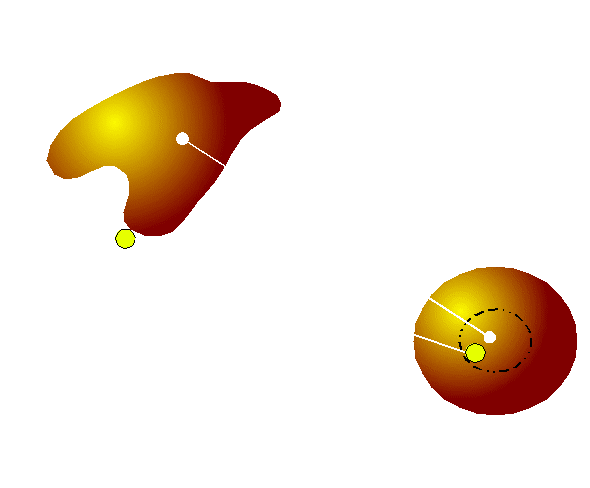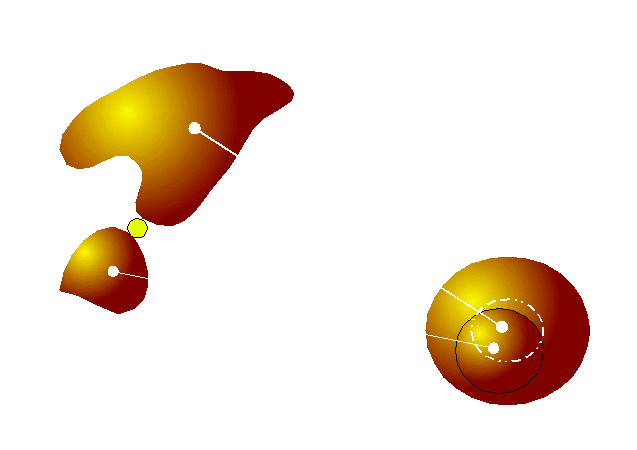The Code
A Gaussian density
field is generated on a grid, in a way much similar to that used to
generate the initial conditions for an N-body simulation. The number
of grid points per side is assumed to be a power of two, so as to use
Fast Fourier Transforms (FFT) (the extension to FFT that use numbers
that are not power of two is in progress).
PINOCCHIO
consists of two step:
 ESTIMATES OF
COLLAPSE TIMES The density field is smoothed on
many scales, equally spaced in logarithm. For each smoothing
radius and for each particle (grid point) we compute the
"collapse time", i.e. the time at which orbit
crossing occurs. Then we consider for each particle the
earliest collapse time (or equivalently the highest collapse
redshift), which is considered as the bona fide collapse time
for the particle. At that time the particle will either enter
a relaxed halo or a lower-density filament. We also record for
each particle its Zel'dovich velocity at the collapse time,
and the smoothing radius at which collapse is predicted to
occur.
ESTIMATES OF
COLLAPSE TIMES The density field is smoothed on
many scales, equally spaced in logarithm. For each smoothing
radius and for each particle (grid point) we compute the
"collapse time", i.e. the time at which orbit
crossing occurs. Then we consider for each particle the
earliest collapse time (or equivalently the highest collapse
redshift), which is considered as the bona fide collapse time
for the particle. At that time the particle will either enter
a relaxed halo or a lower-density filament. We also record for
each particle its Zel'dovich velocity at the collapse time,
and the smoothing radius at which collapse is predicted to
occur.
 FRAGMENTING THE
COLLAPSED MEDIUM The grouping of
orbit-crossed mass elements into haloes mimics the
hierarchical formation of objects. We begin by sorting mass
elements according to decreasing collapse redshift, and,
starting from its highest value we decide the fate of the
collapsed elements, working our way down to the last particle
to collapse. We follow a set of rules for accretion and
merging.
FRAGMENTING THE
COLLAPSED MEDIUM The grouping of
orbit-crossed mass elements into haloes mimics the
hierarchical formation of objects. We begin by sorting mass
elements according to decreasing collapse redshift, and,
starting from its highest value we decide the fate of the
collapsed elements, working our way down to the last particle
to collapse. We follow a set of rules for accretion and
merging.
Accretion:
If a collapsing particle is not a local maximum of the
collapse redshift, we check whether any of its neighbors has
already been assigned to a halo. If the point neighbors a
single halo, then we compute from its Zel'dovich velocity the
position of the halo and of the mass particle at the collapse
redshift, and their mutual distance. If the mass element falls
within a fraction of its typical radius (equal in grid units
to the cubic root of the number of particles) from the center
of mass of the halo, then we accrete the particle onto that
halo. This criterion selects haloes with roughly
fixed overdensity.
|

|
|
|
Merging: If
some of the neighbors of a collapsing particle belong to
different haloes, then we merge these haloes if their distance
(calculated as described above) is smaller than a fraction of
the largest of their typical radii. Moreover, we use the
previous condition to check whether the particle is to be
accreted on one of the groups.
|
Filaments: Collapsed mass elements
which are not local maxima and do not accrete onto a halo
are assigned to a filament group. Note that filaments have
indeed undergone orbit-crossing, although they do not belong
to relaxed haloes. Later, filament points are still accreted
onto a halo if they neighbor an accreting point.
|
|
![]() ESTIMATES OF
COLLAPSE TIMES The density field is smoothed on
many scales, equally spaced in logarithm. For each smoothing
radius and for each particle (grid point) we compute the
"collapse time", i.e. the time at which orbit
crossing occurs. Then we consider for each particle the
earliest collapse time (or equivalently the highest collapse
redshift), which is considered as the bona fide collapse time
for the particle. At that time the particle will either enter
a relaxed halo or a lower-density filament. We also record for
each particle its Zel'dovich velocity at the collapse time,
and the smoothing radius at which collapse is predicted to
occur.
ESTIMATES OF
COLLAPSE TIMES The density field is smoothed on
many scales, equally spaced in logarithm. For each smoothing
radius and for each particle (grid point) we compute the
"collapse time", i.e. the time at which orbit
crossing occurs. Then we consider for each particle the
earliest collapse time (or equivalently the highest collapse
redshift), which is considered as the bona fide collapse time
for the particle. At that time the particle will either enter
a relaxed halo or a lower-density filament. We also record for
each particle its Zel'dovich velocity at the collapse time,
and the smoothing radius at which collapse is predicted to
occur.
![]() FRAGMENTING THE
COLLAPSED MEDIUM The grouping of
orbit-crossed mass elements into haloes mimics the
hierarchical formation of objects. We begin by sorting mass
elements according to decreasing collapse redshift, and,
starting from its highest value we decide the fate of the
collapsed elements, working our way down to the last particle
to collapse. We follow a set of rules for accretion and
merging.
FRAGMENTING THE
COLLAPSED MEDIUM The grouping of
orbit-crossed mass elements into haloes mimics the
hierarchical formation of objects. We begin by sorting mass
elements according to decreasing collapse redshift, and,
starting from its highest value we decide the fate of the
collapsed elements, working our way down to the last particle
to collapse. We follow a set of rules for accretion and
merging.

